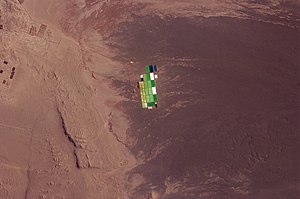A solar pond is a pool of saltwater which acts as a large-scale solar thermal energy collector with integral heat storage for supplying thermal energy. A solar pond can be used for various applications, such as process heating, desalination, refrigeration, drying and solar power generation.
A solar pond is simply a pool of saltwater which collects and stores solar thermal energy. The saltwater naturally forms a vertical salinity gradient also known as a "halocline", in which low-salinity water floats on top of high-salinity water. The layers of salt solutions increase in concentration (and therefore density) with depth. Below a certain depth, the solution has a uniformly high salt concentration.
There are 3 distinct layers of water in the pond:
- The top layer, which has a low salt content.
- An intermediate insulating layer with a salt gradient, which establishes a density gradient that prevents heat exchange by natural convection.
- The bottom layer, which has a high salt content.
If the water is relatively translucent, and the pond's bottom has high optical absorption, then nearly all of the incident solar radiation (sunlight) will go into heating the bottom layer.
When solar energy is absorbed in the water, its temperature increases, causing thermal expansion and reduced density. If the water were fresh, the low-density warm water would float to the surface, causing a convection current. The temperature gradient alone causes a density gradient that decreases with depth. However the salinity gradient forms a density gradient that increases with depth, and this counteracts the temperature gradient, thus preventing heat in the lower layers from moving upwards by convection and leaving the pond. This means that the temperature at the bottom of the pond will rise to over 90 °C while the temperature at the top of the pond is usually around 30 °C. A natural example of these effects in a saline water body is Solar Lake in the Sinai Peninsula of Egypt.
The heat trapped in the salty bottom layer can be used for many different purposes, such as the heating of buildings or industrial hot water or to drive an organic Rankine cycle turbine or Stirling engine for generating electricity.
hope ths helps u.....


